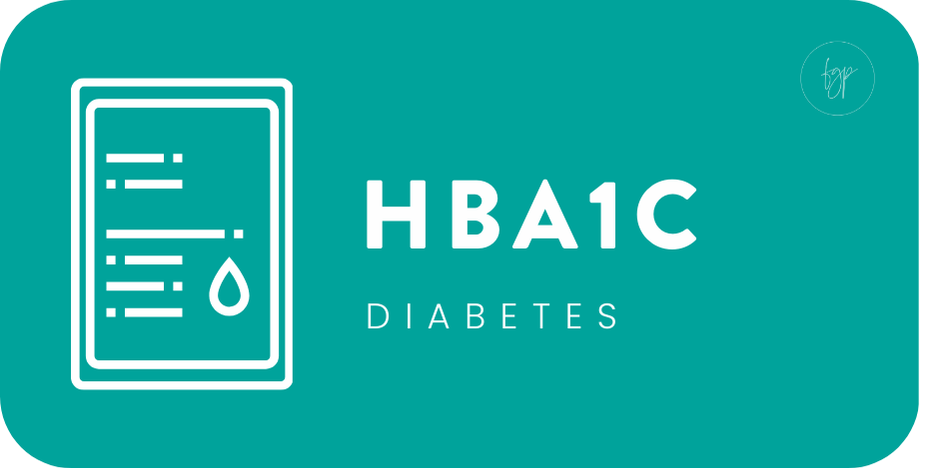What is going on?
Your lab tests

Diabetes Screening
Measures the average blood glucose level over the past 2-3 months by looking at how much glucose is attached to hemoglobin in red blood cells.
What is the normal range?
HbA1c (mmol/mol)
< 40 - Normal
41–49 - At risk (pre-diabetes)
50+ - Type 2 diabetes (diagnosed on two readings, or once if high + symptoms)
It's helpful to know that getting closer to 40 — even if still in the normal range — can mean the body is starting to struggle with blood sugar regulation. It’s not just a yes/no number — trends matter.
HbA1c should be checked every 3-6 months if you have diabetes, every 12 months in prediabetes and every 5 years over 40/45 depending on your cardiovascular risk.
Your result is raised
When Levels are High
High levels indicate poor long-term blood sugar control, commonly seen in diabetes, and prediabetes. This is why we monitor it, to avoid the complications associated with diabetes.
Your result is low
When Levels are Low
A normal HbA1c is typically below 41 mmol/mol.
This tells us that your average blood sugar levels over the past 2–3 months have been within a healthy range — meaning your body is currently keeping your blood glucose in balance.
But! Even within the "normal" range, there's more to consider: Closer to 40? It might be time to check in on things — especially if it's trending up or you're feeling off (like fatigue or weight changes). Big jumps over time, even within the normal range (e.g. 31 → 38), can hint at rising insulin resistance.
It’s not just the number — it’s the story the trend tells and what else is going on in your body. Normal is good, but not the whole picture — especially if there are risk factors like:
- Family history of type 2 diabetes
- Past gestational diabetes or PCOS
- Menopause or hormonal shifts
- Weight changes or metabolic concerns
Low levels are rare but may occur in cases of anemia, hemoglobinopathies, or when a person has had low blood sugar over the long term.
WE’RE HERE TO HELP YOU
Understanding trends in the results
Persistent high HbA1c levels suggest a risk of developing diabetes or poor management of existing diabetes. Gradual increases can indicate worsening blood sugar control, while sudden drops may require a closer look at the individual’s lifestyle, diet, and medication. A steady rise over time could signal the need for changes in treatment or lifestyle.
A deeper dive
⚙️ What is Hyperinsulinaemia?
Hyperinsulinaemia means your body is producing too much insulin. This develops because your cells are becoming resistant to insulin’s effects. So your pancreas pumps out more and more insulin to try to keep your blood sugar in a safe range.
🧠 Think of insulin as the key that unlocks the cell door so sugar can get inside. If the lock is rusty (resistant), the body sends more keys (insulin). Eventually, this leads to wear and tear on the system.
Hyperinsulinaemia
often happens before
blood sugar rises — so someone may have “normal” HbA1c, but still be showing early signs of metabolic stress.
🍩 What is Impaired Glucose Tolerance (IGT)?
This is usually picked up on an oral glucose tolerance test (OGTT) — where you drink a sugary drink and have blood sugar measured at set times afterward. If your blood sugar is slow to come down, but not high enough for a diabetes diagnosis, it’s called Impaired Glucose Tolerance. It’s another form of prediabetes — just measured a different way.
🔄 How do these all relate?
Here’s a simplified flow:
- Hyperinsulinaemia = early sign that insulin resistance is starting
- Over time, insulin can’t keep up, and blood sugars start to rise
- This becomes Prediabetes (seen in HbA1c or glucose tests)
- Without change, it may eventually become Type 2 Diabetes
You can have hyperinsulinaemia for years before HbA1c ever shows anything. That’s why looking at the whole story — energy levels, waist gain, PCOS, sleep issues, hunger, etc. — is just as important.
💬 In real life?
- Someone might say, "But my sugars are fine!" — and yes, they might be for now.
- But if their body is working overtime with insulin to keep them in range, they could be on the edge of metabolic burnout.
- This is where earlier, supportive changes really shine — because you’re working with your body while it’s still adaptable.
⚙️ What is Hyperinsulinaemia?
Hyperinsulinaemia means your body is producing too much insulin. This develops because your cells are becoming resistant to insulin’s effects. So your pancreas pumps out more and more insulin to try to keep your blood sugar in a safe range.
🧠 Think of insulin as the key that unlocks the cell door so sugar can get inside. If the lock is rusty (resistant), the body sends more keys (insulin). Eventually, this leads to wear and tear on the system.
Hyperinsulinaemia often happens before blood sugar rises — so someone may have “normal” HbA1c, but still be showing early signs of metabolic stress.
🍩 What is Impaired Glucose Tolerance (IGT)?
This is usually picked up on an oral glucose tolerance test (OGTT) — where you drink a sugary drink and have blood sugar measured at set times afterward. If your blood sugar is slow to come down, but not high enough for a diabetes diagnosis, it’s called Impaired Glucose Tolerance. It’s another form of prediabetes — just measured a different way.
🔄 How do these all relate?
Here’s a simplified flow:
- Hyperinsulinaemia = early sign that insulin resistance is starting
- Over time, insulin can’t keep up, and blood sugars start to rise
- This becomes Prediabetes (seen in HbA1c or glucose tests)
- Without change, it may eventually become Type 2 Diabetes
You can have hyperinsulinaemia for years before HbA1c ever shows anything. That’s why looking at the whole story — energy levels, waist gain, PCOS, sleep issues, hunger, etc. — is just as important.
💬 In real life?
- Someone might say, "But my sugars are fine!" — and yes, they might be for now.
- But if their body is working overtime with insulin to keep them in range, they could be on the edge of metabolic burnout.
- This is where earlier, supportive changes really shine — because you’re working with your body while it’s still adaptable.

